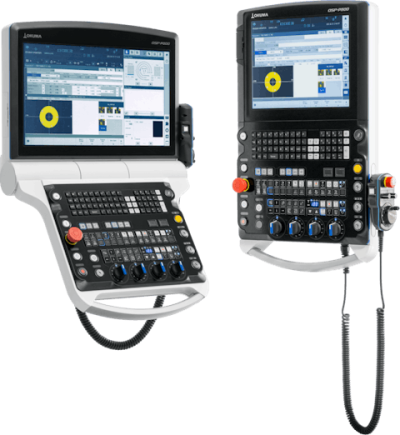
The leadership team at Okuma America Corporation is pleased to announce the launch of the company’s next-generation machine control for its expansive line of CNC (computer numeric control) machine tools. The new control – the Okuma OSP-P500 – is the company’s latest innovation within its OSP control line which dates back to 1963. Leveraging the OSP line’s 60-year history, coupled with today’s digital transformation technologies, the OSP-P500 is designed to enhance user experiences and fully optimize modern manufacturing operations.
Processing Power and Ease of Use
The OSP-P500 is designed with today’s high-speed, high-accuracy manufacturing operations in mind. The new control comes standard with dual-core computer processors which provide increased levels of machine processing power by enabling multiple processes to operate simultaneously. This results in reduced cycle times per machined part and shortened production run times. The dual-core processors also provide redundant operations, thus ensuring uninterrupted machining operations.
Most notably, the OSP-P500 is fully equipped with Digital Twin Technology, a technology that enables high-precision machining simulations to be created on a computer, while also providing real-time data feedback loops from the operational machine tool to the simulating computer. This feature allows operators to utilize real-time data to mirror exact machine tool functions and behaviors to optimize performance.
Operator and Secure Operation
The OSP-P500 is designed with the user in mind. Built on a Microsoft Windows, open-architecture platform, coupled with on-board conversational programming capabilities, the OSP-P500 is among the easiest machine controls to program on the market. Additionally, new ergonomic features, including screen tilt and swivel capabilities, allow for comfortable machine operation by all operators.
As modern manufacturing practices become more reliant on digital data collection, assessment, and transfer, the need for data protection is paramount. The Okuma OSP-P500 is designed with robust protective features to manage data exposure risks, including: 1) tamper-proof protection 2) whitelisting of the machine’s API, 3) anomaly detection, 4) required operator identification and authentication, and 5) regularly scheduled software and data back-ups.
Smart and Green Machine Technologies
In addition to its smart, cutting-edge machining performance capabilities, the OSP-P500 is also designed with the environment in mind. The new control comes standard with Okuma’s proprietary ECO suite plus technology, a collection of digital features that monitor, control, and perfectly balance energy consumption with optimal machining performance. Additionally, the ECO suite plus application affords the ability to report on CO2 emissions at the machine level.
Notable Features of the OSP-P500 CNC Control:
- Two sizes: 15” screen or 21.5” screen based on machine size
- Space-saving, modern design
- Ergonomic tilt and swivel capabilities
- QWERTY keyboard
- Full-color touchscreen
- Pulse handle options available
- Windows-based operating system
- Open architecture platform for integration to Apps on Okuma App Store
The OSP-P500 will make its Western-hemisphere debut at the Gosigerfest event in Dayton, OH, on September 13, 2023. It will be available for purchase in the Americas beginning in the Fall of 2023 on select Okuma machine tool models. The new control will become available on a wider variety of Okuma models throughout 2024.
Contact Details
Related Glossary Terms
- computer numerical control ( CNC)
computer numerical control ( CNC)
Microprocessor-based controller dedicated to a machine tool that permits the creation or modification of parts. Programmed numerical control activates the machine’s servos and spindle drives and controls the various machining operations. See DNC, direct numerical control; NC, numerical control.
- conversational programming
conversational programming
Method for using plain English to produce G-code file without knowing G-code in order to program CNC machines.

